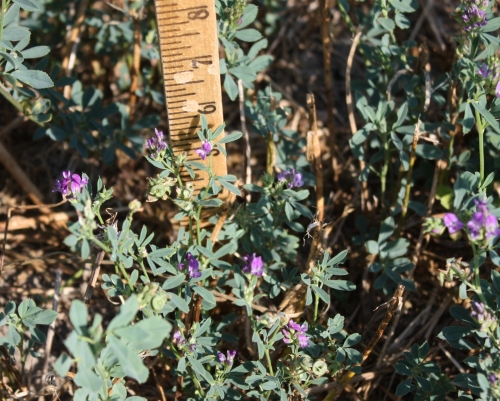Managing alfalfa during drought
Adjusting harvest management during drought may salvage some yield and aid alfalfa recovery.
During drought, forage is often in short supply, and producers are driven to look for every possible pound of yield. Harvest timing decisions for alfalfa during drought should be based on plant maturity stage and yield estimates. Alfalfa is deep-rooted, allowing it to find water longer than some other forages. It also has the ability to go dormant and wait out more severe droughts, making it well-adapted to survive drought when managed appropriately to keep other stresses to a minimum.
Whenever plants are stressed, it becomes especially important to make sure they are allowed to replenish the energy and protein stores in the roots, because these are vital to support new growth from buds in the crown once conditions improve. Failure to allow alfalfa to recharge root reserves greatly increases the odds that plants may not survive adversity. We generally accept that root reserves are fully recharged when plants have reached full flower stage. Full flower occurs when every full-height stem has at least one open flower.
Drought-stressed alfalfa will accelerate its maturation process in an attempt to complete its seed production cycle as quickly as possible. Stem internode growth is suppressed, resulting in a greater proportion of leaves on shorter stems. Flowers will develop more quickly than in a normal growth cycle and may appear on stems that are only four to six inches tall in as few as 14 days after the last cutting. Once a stem has flowered, there will be little additional growth in that stem. In the short term, the greater proportion of leaves in the drought-stressed forage improves feed quality and digestibility, but yield is reduced because of the short stems. If drought continues long term, both yield and quality will decline because alfalfa will drop its leaves as it goes completely dormant.
The big question when deciding whether or not to harvest a droughty alfalfa crop is whether or not enough yield exists to cover the cost of harvest. Keep in mind that value per ton of forage may increase when supplies are short and allow a profitable harvest at yields lower than the normal break-even yield. If the decision is made to cut, use the normal recommended cutting height of two inches for pure alfalfa stands. There is no advantage to the alfalfa plant of leaving higher stubble during drought. Greater stubble heights encourage regrowth from axillary buds at the base of cut stems, which are lower yielding growth points than the crown buds which are encouraged by close cutting. For mixed stands of alfalfa and a desirable grass, cut at the recommended stubble height for the grass if that is greater than two inches. For example, recommended cutting height for orchardgrass is four inches, and therefore alfalfa/orchardgrass mixtures should always be cut at four inches.
If an economical mechanical harvest is not feasible, it is possible to salvage some value from the crop by grazing it. Alfalfa makes excellent pasture for all types of grazing livestock, but it can cause bloat, especially in animals that aren’t used to grazing it. To reduce bloat risk, let animals take the edge off their hunger by feeding hay before turning onto alfalfa pasture, avoid grazing alfalfa wet with dew or rain, use a heavy stocking rate to discourage animals from eating only the leaves, and consider feeding a bloat preventative.
If stands will not yield enough hay or haylage to cover the cost of harvest, and grazing is not feasible, then it will not harm the alfalfa to leave it uncut until the drought breaks and dormancy is broken. It is not necessary for health of the stand to clip off the old droughty stems before the next harvest. However, the old stems will decrease forage quality of the new harvest to an extent proportional to the amount present. Such hay should not be marketed for animals such as high-producing dairy cows, but it is suitable for most other classes of animals.
Regardless of harvest management, stands should continue to be monitored for insect problems through the drought and treated if necessary, especially for potato leafhopper. Scheduled fertilizer applications should continue as indicated by soil test. Plentiful potash (potassium) is particularly important in helping plants tolerate drought stress, and drought is not the time to skimp on this nutrient.
For more information, contact Michigan State University Extension Forage Specialist, Kim Cassida at cassida@msu.edu or 304-575-6099.

This drought-stunted alfalfa plant has already set seed with stems less than six inches tall at the normal time for second cutting.
Additional information:
- MSU Extension’s Drought Resources



 Print
Print Email
Email




